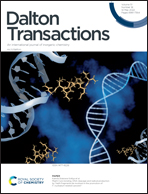Tunable emission of Li4SrCaSi2O4−yN2y/3:Eu2+ phosphors based on anion substitution induction for WLEDs and optical thermometry†
Abstract
Polychromatic emission can be achieved by controlling the distribution of the rare earth activator in multi-cation lattices, which can be used in the fields of white light LED and fluorescence temperature sensing. However, it is still a challenge to control their distribution and location of the target site in a given host material because the distribution of the rare earth activator is uncertain. In this paper, we have chosen Li4SrCa(SiO4)2 as the multi-cation site host and induced the distribution of Eu2+ ions between different cation sites through anion substitution, for the first time, to regulate the luminescence characteristics of a series of Li4SrCaSi2O8−yN2y/3:Eu2+ phosphors. In Li4SrCa(SiO4)2:Eu2+ phosphors, the substitution of O2− by N3− triggered a distinct ordered to disordered structure transition of the SiO4 tetrahedron and induced the remote distribution of the Eu2+ activator, which was verified through the analysis of the XRD, EPR, FT-IR and fluorescence spectra. Due to the location of Eu2+ ions in different cation sites (Eu2+Sr and Eu2+Ca), two distinguishable emission peaks with tunable color emissions and different responses to temperature were realized. The white LED that utilized blue-orange-emitting Li4SrCaSi2O4N8/3:Eu2+ and green-emitting BaSi2O2N2:Eu2+ (500 nm) displayed an outstanding color rendering index (Ra) of 85.1. Based on the fluorescence intensity ratio (FIR) technique, an optical temperature measurement mechanism was hypothesized and studied in the temperature range of 293–473 K. The highest Sa of the material was 0.086 K−1, and Sr was 1.76% K−1 based on the FIR detection technology, revealing obviously better than most inorganic optical temperature-measuring materials reported before. Our work indicates that Li4SrCaSi2O8−2yN4y/3:Eu2+ is a promising material for application in White LEDs and optical thermometers.



 Please wait while we load your content...
Please wait while we load your content...